Vaccination for COVID-19 is a large project that requires a solid strategy and use of technology to be successful. Currently, a lot of countries are struggling with executing their vaccination plans, especially bottlenecks in the process of vaccine delivery. When the first vaccines were registered, many people were surprised by the fact that they must be delivered at certain temperatures – they didn’t know that logistics companies have been delivering temperature-sensitive cargos for decades and already had all the necessary tools and technology in place to do the job right away. So what is the problem with deliveries then? We’ll look at some of the challenges and delivery process aspects in this blog post.
Mapon headquarters is based in Latvia, thus we decided to use Latvia as a country of reference to build our case study. Then we took the publicly available data about the vaccination process, uploaded it to our fleet management platform and made some guesses and data interpretation to model a situation using the real-world data. However, it should be noted that we haven’t been directly involved in the delivery process, therefore are offering only a theoretical concept of how fleet management and route planning solutions can help to manage the vaccine distribution process.
Handling the delivery process
In order to successfully distribute the vaccines, there must be a well-planned delivery process behind it. If there’s no plan, problems are guaranteed. To clarify, we’ve identified several steps in the delivery process which are pretty much identical for any type of delivery:
- Receiving orders;
- Handling supplies;
- Planning and optimising routes and delivery strategies;
- Order picking;
- Executing routes;
- Notifying the recipients about the order status.
Let’s go through all of the points one by one.
Receiving vaccine orders
The success of the delivery process is directly proportional to the input data quality. If you can feed the route planning and optimisation solution with high-quality data you can expect the planning process to be smooth. But in case the data quality is low, it’s almost guaranteed that the delivery process will have some struggles. When talking about orders it’s important to note that there are several critical parameters to take into account:
- Delivery address or coordinates. The more delivery destinations, the more complex is route planning and optimisation;
- The number of vaccines to deliver can impact route planning due to cargo size limitations;
- Delivery time windows will definitely impact route planning and optimisation as the time windows might require additional driving to match the time window requirements;
- Contact information of the recipient. In case of delays or issues with delivery (for example, the driver can’t find the correct entrance of the building) contact information is a critical component.
According to publicly available information, vaccine orders in Latvia are currently collected until 11:00 AM every Thursday and should cover the next week vaccination plans. During the vaccine order process, the vaccination centres have to fill in a form and send it over to the responsible government agency. Unfortunately, this looks like a manual process for both parties – the vaccination centres filling in the forms and the government agency processing the data.
Mapon fleet route optimisation and planning solution allows several options on how to receive the orders. The simplest and most straightforward is a manual data entry into the platform, but, keeping in mind that manual labour is slow and error-prone, we would suggest using at least XLS file import or, in the best-case scenario, API integration to directly transfer the data into the Mapon platform.
We should also mention that for some cargo types it would be important to keep track of the vehicle load capacity and order delivery size. Given the current vaccine availability and packaging size, we can skip this step for now. However, our route planning solution can plan deliveries based on the vehicle size/weight constraints, if necessary.
Looking at the actual situation with the Latvian vaccination centres and publicly available information, we see that
there is a list of vaccination centres, the addresses are of rather good quality and contact information is also available. Unfortunately, the data is easy to view, but not easy to export, thus we decided to use around 539 vaccination centre locations for this blog post.
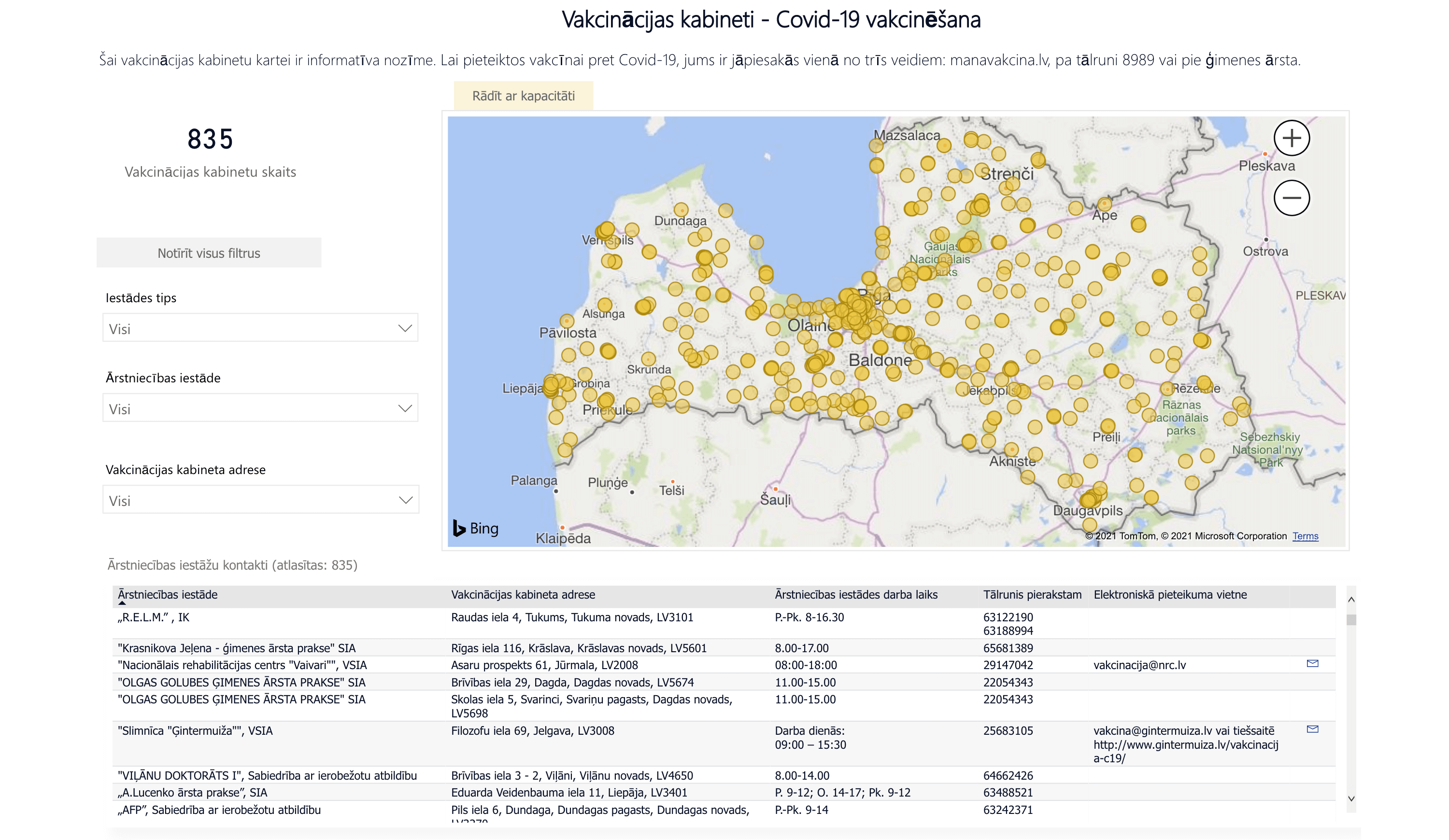
Although the dataset also includes time windows, we believe that they represent the vaccination time windows rather than the working hours of the vaccination centres. This is our conclusion after looking at several vaccination centres in the above-mentioned list and comparing the data with other publicly available information. Additionally, we saw that the time window data is of very low quality, thus it would require a lot of manual work to prepare it in a machine-readable format.
Mapon route planning solution allows defining specific delivery time windows, however, since we’re currently in an emergency situation, vaccination centres should be able to accept the vaccines on any day at their regular business hours. Otherwise, if there’s, for example, a vaccination centre that is working only on Thursdays from 11:00 to 15:00, there might be a case when a separate vehicle needs to be sent to this address just to deliver a few vaccine doses, which makes the whole process inefficient.
In order to test the route planning solution,
we decided to work with the previously extracted data about the 539 vaccination centres and deliver an imaginary 20 doses of vaccines to each of them, which would make a total of 10 780 vaccine doses.
After doing some data cleanup, our first step was to import all of the potential orders into our route planning solution.
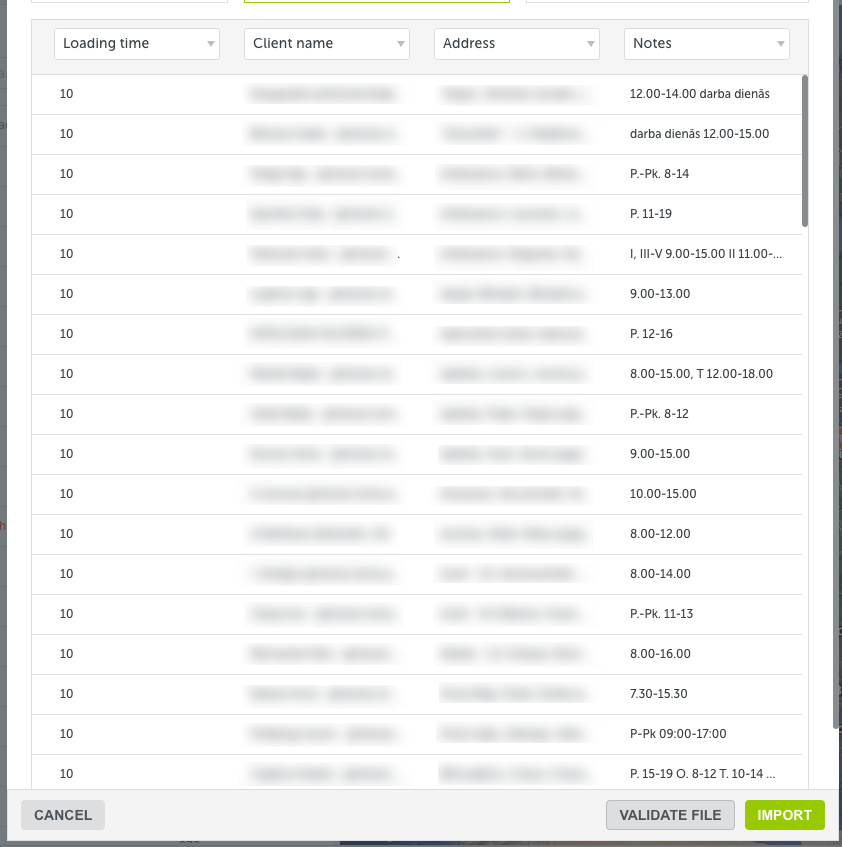
Route optimisation
Once we have all orders set up in the route optimisation, we can start planning for deliveries. The screenshot below shows a sample scenario of delivering 20 vaccine doses to each of the vaccination centres.
As you can see, the total time to deliver 20 vaccine doses to each of the addresses is 319 hours, it requires at least 33 vehicles and 13668.7 km to drive. But what if we only have 20 vehicles? In that case, we’d have to split deliveries into two or more days.
Here are a few ideas worth considering to ensure a more efficient vaccine delivery:
- Don’t distribute vaccines evenly across the vaccination centres. Instead, maybe skip some vaccination centres in order to optimise delivery time;
- Introducing high-capacity vaccination centres is definitely easier than handling 10 last-mile deliveries in regions. They wouldn’t only help to optimise the patient queues but also reduce the mileage of the delivery vehicles, thus lowering the vaccine distribution costs.
Now, let’s see how having some additional limitations might influence the delivery time calculations. One of the constraints, in this case, could be the EC regulations which say that an employee must take a 30 minute break after 6 hours of working. If necessary, we can also include this limit in our route planning solution.
Another thing worth mentioning is that the Mapon platform also provides an option to implement driving time limits based on EC regulation 561/2006 and use the real-time data from digital tachographs.
When choosing the delivery and route optimisation strategy, it’s also important to take into account the time spent on site when unloading. In our case study, we used route optimisation settings with 10 minutes of unloading time which seems like a normal time for discharging. Now, let’s do some basic calculations on the time we can save by reducing unloading time.
We have 539 addresses. For each minute we save on unloading, we can reduce the total delivery time by 539 minutes, which is almost 9 hours. Looking at the average 9-hour route, we can see that for each minute we save on unloading we can let us reduce the number of delivery vehicles by one. So, if we saved, for example, 3 minutes on each unloading, we’d need 3 vehicles less to complete all deliveries.
What happens if we forget to add this time when planning the routes? The answer is pretty clear – we will mess things up and the deliveries later in the day will be way off the planned time.
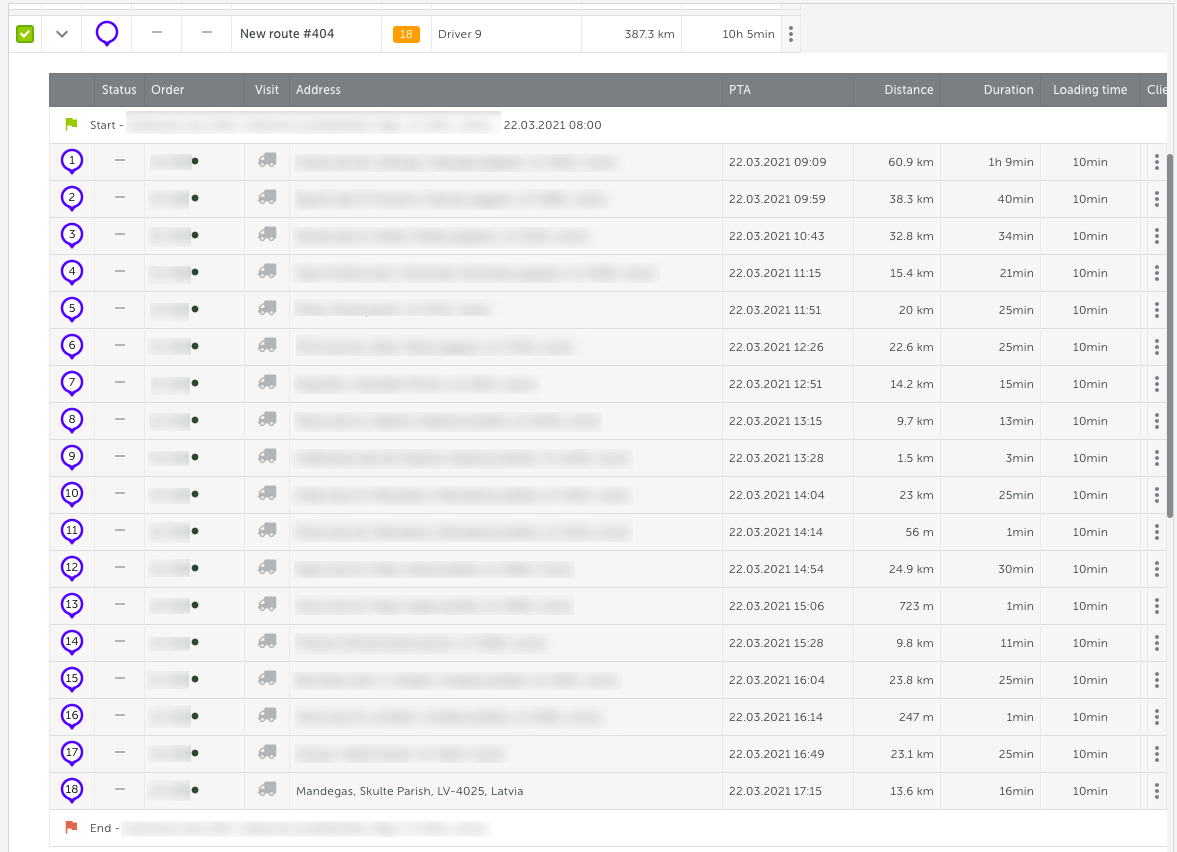
So, once we’ve chosen our delivery strategy, we can move on to the execution stage.
Executing routes
It seems that all the work is done once the routes are planned and handed off to the drivers. Unfortunately, it’s only a part of the process of executing a successful delivery. Timely and well-planned order preparation is also important – when it’s done right, the driver only needs to pick the order up and deliver it to the final destination.
When talking about vaccines, it’s important to note that, in most cases, delivery includes not only the vaccines but also other consumables necessary for vaccination, for example, syringes, alcohol wipes, gloves, etc. Arranging such delivery includes decent management in the warehouse since there’s no point in delivering one component if another one is unavailable.
We won’t go much into detail about how to optimise work in the warehouse and control the supply chain, but there are still a few tips that might be helpful:
- Plan both for deliveries and delivery order in the route. If the driver will have to dig through piles of cold bags in order to find the right one for a specific delivery it will take a lot of time at each of the unloading locations. Ideally, the cargo should be loaded in a way that the driver just opens the door and takes out the next full cold bag to deliver;
- Clearly mark the packages so that the driver can quickly verify he has taken the right one. Small letters and handwritten notes are the straight paths to delivery errors.
Once the picking and packing is done, the driver is ready to roll.
In order to guarantee a smooth delivery process, it’s important to notify the delivery locations of estimated delivery times.
In our case, we can easily export the routes and notify the vaccination centres of the planned time of arrival.
However, sometimes things don’t go according to plan. The delivery vehicle may break down or some delays might happen due to bad weather conditions. These situations can be easily handled by keeping track of planned times of arrival (PTA) and notifying the delivery location of the new estimated time of arrival (ETA). To help with that, there’s an easy-to-follow dashboard in the Mapon route planning solution that shows which vehicles are late for delivery.
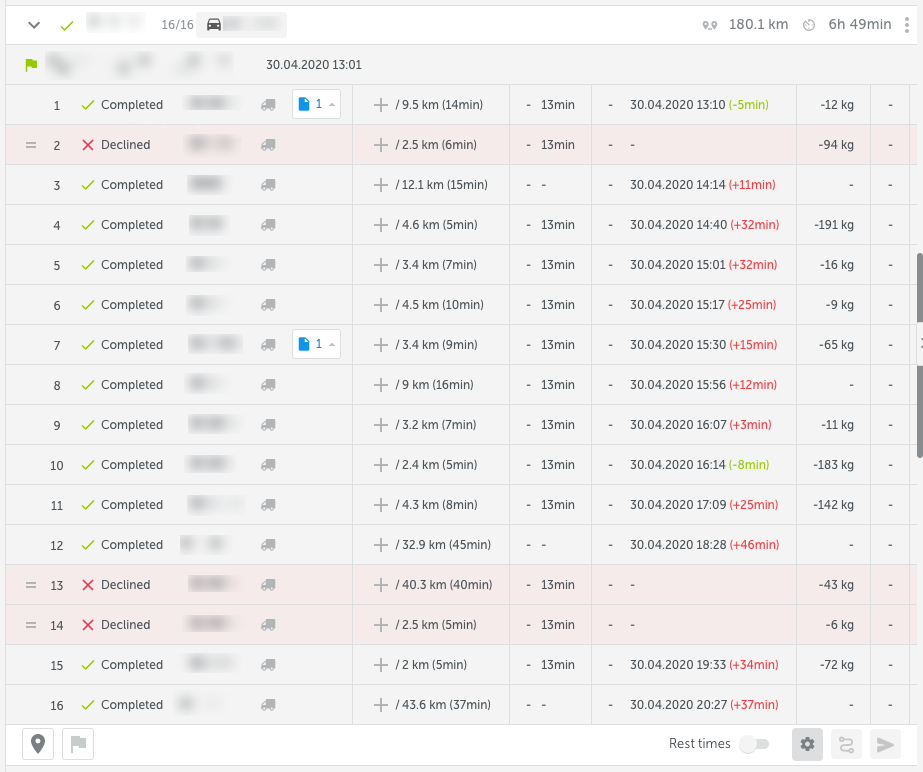
After checking the dashboard, you can contact the delivery locations and notify them about the delay.
We can, of course, rely on the drivers to do the routing themselves. However, we strongly recommend using a driver mobile application for deliveries in order to keep track of any possible delays.
Mapon Driver application provides a smooth process of route execution – the driver opens his mobile app, starts the route, marks the delivery in progress and uses navigation software on his device. The data about route order statuses is updated automatically on the Mapon PRO platform.
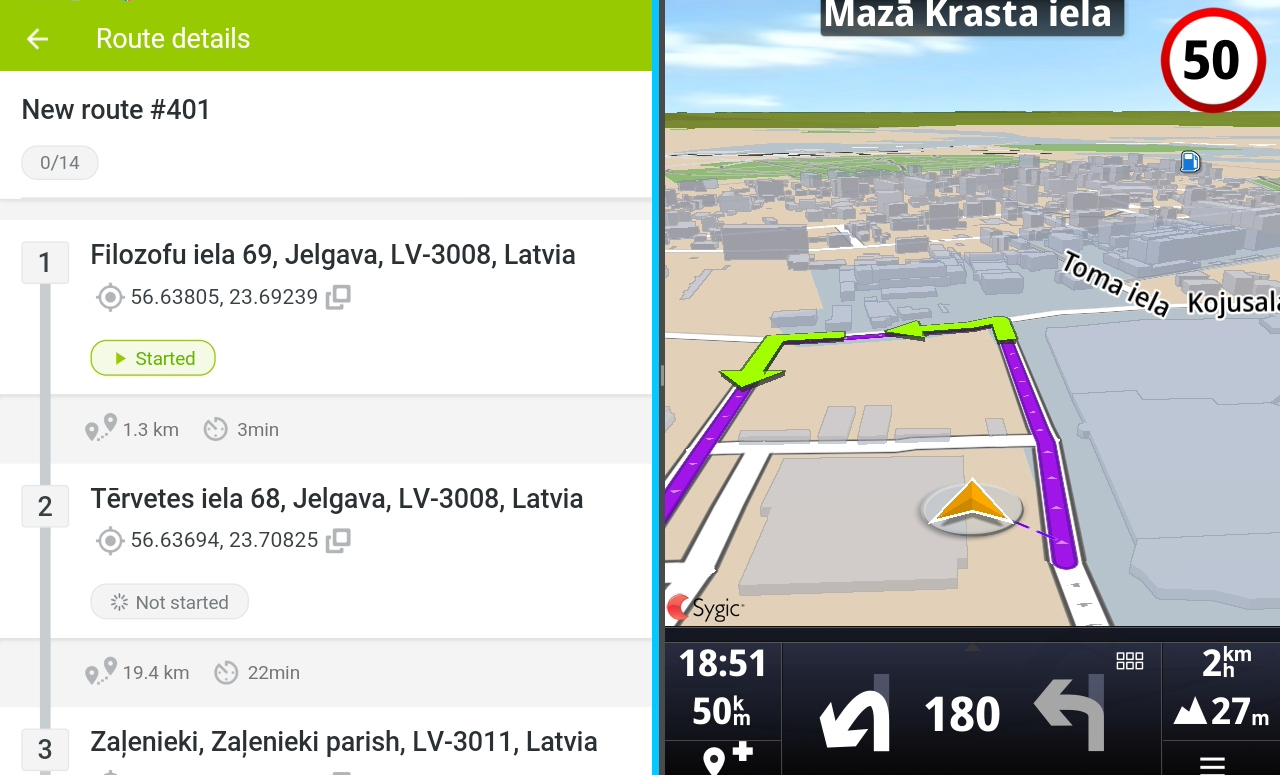
Keeping track of the cargo
Fleet management platforms like Mapon operate based on the data retrieved from tracking devices that are installed in the vehicles, thus, the first step towards efficient delivery process management is to make sure all delivery vehicles in the fleet are equipped with tracking hardware. This may sound like a burden, but it isn’t. In fact, there are tracking devices available in the market which can be installed as simply as by connecting them to the vehicle battery or an OBD-II port.
Vaccines are temperature-sensitive goods. It means that you have to constantly keep track of the temperature at which they’re being transported. Although this seems like a challenge, it isn’t to fleet management platforms – all you need is an easy-to-install temperature sensor that is either installed in the vehicle or simply placed into the cold bags.
During the delivery, you can set up temperature deviation alerts and review a temperature chart in near-real-time or after the delivery. In cases extreme temperatures are required for transport, the only challenge is to find sensors that support the required temperature range.
There’s a limited supply of vaccines and, apart from temperature tracking, in some cases, there might also be a decent security risk involved in transporting them. To keep the valuable cargo safe, additional sensors can be used to track the door or cold bag opening and to receive alerts on when that happened. Moreover, even an SOS button can be installed in the vehicle for the safety of both the driver and the cargo.
Fleet management solutions are well-suited for managing various types of deliveries, including temperature-sensitive goods such as vaccines. However,
using a solution like Mapon is just part of the actual project – a lot depends on choosing the right strategy for vaccine delivery, organising the vaccination centres, gathering high-quality data for delivery locations and their contact information as well as preparing vaccines for deliveries to make sure the whole process runs as smoothly as possible.
Over the course of this blog post, we’ve identified some potential scenarios and ideas on how to avoid potential vaccine delivery bottlenecks and inefficiencies. Feel free to apply them to your projects or reach out to us, if you have any questions! Moreover, if you’re currently not using fleet management software or route planning and optimisation solution, make sure you start doing it as it will allow you to model various delivery strategies and optimise them for your specific situation.

